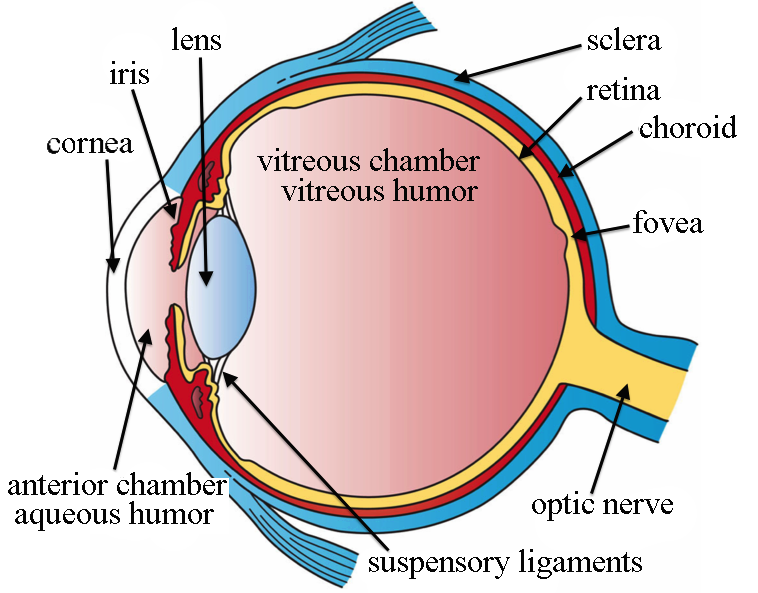
Explain the structure of the transparent and bulging part of the sclera. Also, where is it found?
Answer
449.1k+ views
Hint: Human eye is an essential organ that interacts with light and is necessary for a sense of sight or vision. The human eye operates similarly to a digital camera in a way. There is a protective white tough covering outside the eye.
Complete answer:
The human eye is the specialised sensory organ that is capable of forming visual images and then carrying them forward to the brain. The various parts of the eye are the cornea, Pupil, Iris, lens, vitreous humour and retina. It collects light from the visible view and converts them into nerve impulses then the optic nerve transmits the signals to the brain which forms an image, therefore, providing the sight.

The sclera is the white layer of the eye that is transparent and bulging and its main function is to protect the eye. The central region of the eye is transparent and called the cornea.
The sclera divides into the following three divisions:-
Episclera: it’s a loose connective tissue beneath the conjunctiva;
Sclera proper: it is a dense white tissue responsible for the white colour of the eye;
Lamina fusca: it is the innermost zone of elastic fibres.
The sclera is the outside covering of the white layer and the conjunctiva is just in front of the sclera like a window called the cornea that protects the Pupil and Iris behind that window. When the white part of your eye called the sclera is inflamed or hurt, that condition is called scleritis.
Note: The Eyes are sensory organs that detect light which will provide the sense of vision. Eye is a very delicate organ in order to persist a sense of Sight or vision, therefore protected by various layers including the white layer in the human eye. The white layer in the human eye is called the sclera. The sclera is opaque, white, the tough protective covering of the eye.
Complete answer:
The human eye is the specialised sensory organ that is capable of forming visual images and then carrying them forward to the brain. The various parts of the eye are the cornea, Pupil, Iris, lens, vitreous humour and retina. It collects light from the visible view and converts them into nerve impulses then the optic nerve transmits the signals to the brain which forms an image, therefore, providing the sight.

The sclera is the white layer of the eye that is transparent and bulging and its main function is to protect the eye. The central region of the eye is transparent and called the cornea.
The sclera divides into the following three divisions:-
Episclera: it’s a loose connective tissue beneath the conjunctiva;
Sclera proper: it is a dense white tissue responsible for the white colour of the eye;
Lamina fusca: it is the innermost zone of elastic fibres.
The sclera is the outside covering of the white layer and the conjunctiva is just in front of the sclera like a window called the cornea that protects the Pupil and Iris behind that window. When the white part of your eye called the sclera is inflamed or hurt, that condition is called scleritis.
Note: The Eyes are sensory organs that detect light which will provide the sense of vision. Eye is a very delicate organ in order to persist a sense of Sight or vision, therefore protected by various layers including the white layer in the human eye. The white layer in the human eye is called the sclera. The sclera is opaque, white, the tough protective covering of the eye.
Recently Updated Pages
Master Class 11 Economics: Engaging Questions & Answers for Success

Master Class 11 English: Engaging Questions & Answers for Success

Master Class 11 Social Science: Engaging Questions & Answers for Success

Master Class 11 Biology: Engaging Questions & Answers for Success

Class 11 Question and Answer - Your Ultimate Solutions Guide

Master Class 11 Business Studies: Engaging Questions & Answers for Success

Trending doubts
10 examples of friction in our daily life

One Metric ton is equal to kg A 10000 B 1000 C 100 class 11 physics CBSE

Difference Between Prokaryotic Cells and Eukaryotic Cells

1 Quintal is equal to a 110 kg b 10 kg c 100kg d 1000 class 11 physics CBSE

Explain zero factorial class 11 maths CBSE

What is a periderm How does periderm formation take class 11 biology CBSE




